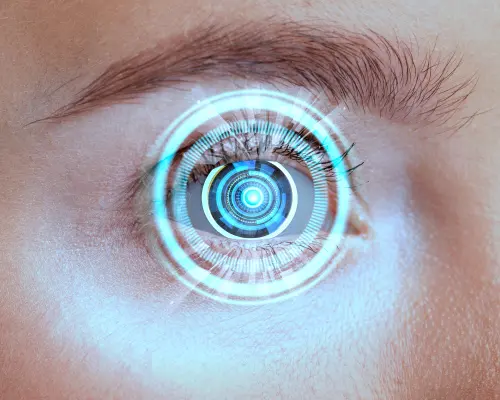Cornea and refractive Surgery in Zaheerabad
Home/Services/Cataract Surgery

WHAT IS CORNEA AND REFRACTIVE?
Understanding About Cornea and refractive
Symptoms of Cornea and refractive
Corneal Issues
- Blurred Vision
- Eye Pain
- Redness
- Sensitivity to Light
- Tearing or Discharge
- Foreign Body Sensation
Refractive Issues
- Blurred Vision
- Headaches
- Eye Strain
- Double Vision
- Difficulty with Night Vision
- Frequent Changes in Prescription
Treatments for Corneal and Refractive Issues
Corneal and refractive issues are managed through various treatments aimed at restoring vision and alleviating symptoms. For corneal problems, treatments depend on the condition’s severity. Mild issues like dry eyes may be addressed with lubricating eye drops or ointments. More severe conditions, such as corneal ulcers or infections, may require antibiotic or antiviral medications, and sometimes surgical intervention like corneal transplants.
Refractive errors, such as myopia, hyperopia, and astigmatism, are commonly corrected with corrective lenses, including glasses or contact lenses. For those seeking a more permanent solution, refractive surgery options like LASIK or PRK can reshape the cornea to improve vision. Additionally, orthokeratology (Ortho-K) involves wearing specially designed contact lenses to temporarily reshape the cornea overnight. Regular eye exams are crucial for monitoring and adjusting treatments to ensure optimal visual health and comfort.
To maintain healthy corneas and prevent refractive issues, adopting certain precautions is essential. For corneal health, avoid touching or rubbing your eyes, as this can cause irritation or infection. Ensure proper hygiene by washing hands before touching your eyes and using clean contact lenses. Protect your eyes from harmful UV rays by wearing sunglasses with UV protection. Regular eye check-ups are crucial for early detection of corneal problems.
For refractive health, reduce eye strain by following the 20-20-20 rule: every 20 minutes, look at something 20 feet away for at least 20 seconds. Ensure adequate lighting while reading or using screens, and take frequent breaks. Keep your prescription glasses or contact lenses updated to avoid discomfort and vision issues. Lastly, consider regular eye exams to monitor changes in vision and address any emerging refractive errors promptly.
Different Types of Cornea and refractive
Myopia
Difficulty seeing distant objects clearly while close objects are seen well.
Hyperopia
Difficulty seeing close objects clearly while distant objects are seen well.
Astigmatism
An irregular curvature of the cornea or lens, causing blurred or distorted vision at all distances.
Presbyopia
Age-related loss of the eye’s ability to focus on near objects, typically starting in the mid-40s.
Anisometropia
A condition where there is a significant difference in the refractive power of each eye, leading to uneven vision.
Amblyopia
Reduced vision in one eye due to abnormal visual development early in life, which can be associated with refractive errors.
FAQs
What is corneal disease, and what are its symptoms?
Corneal disease refers to various conditions affecting the cornea, such as keratitis or corneal dystrophy. Symptoms often include blurred vision, eye pain, redness, sensitivity to light, and tearing.
How can I prevent corneal infections?
To prevent corneal infections, practice good hygiene by washing your hands before touching your eyes, avoid rubbing your eyes, use contact lenses as directed, and replace them regularly. Also, avoid using expired or contaminated eye products.
What are the common refractive errors?
Common refractive errors include myopia (nearsightedness), hyperopia (farsightedness), astigmatism, and presbyopia (age-related difficulty focusing on close objects).
Our Services
Book An Appointment
Why Choose Eyecare Optical and Clinic ?
- Experienced Doctors
- Cutting-edge Technology
- 1000+ Trusted Patients
- 10+ Years Services
- 10,000+ Surgeries
- 100% Accurate Results
- Quick Recovery
- Your Vision Is Our Focus
- Treatments

Customised LASIK
Personalized LASIK is a type of vision correction surgery that is more accurate and specific than normal LASIK since it is customized to the specific flaws in each patient's eye.

Retina Services
Retinal services include specialist medical care for the diagnosis, treatment, and management of disorders and diseases that impact the retina.

Corneal Services
The clear front surface of the eye, the cornea, is affected by a variety of diseases and ailments, which Corneal Services specializes in identifying, treating, and managing.

Anti-VEGF Agents
Anti-VEGF therapies are drugs that prevent aberrant blood vessel formation and leakage by blocking vascular endothelial growth factor (VEGF).

Epi-LASIK
A form of refractive surgery called epi-LASIK uses a laser to separate and reshape the corneal epithelium in order to treat visual issues like astigmatism, hyperopia, & myopia.

Dry Eye Treatment
To control symptoms and enhance tear production, dry eye treatment options include prescription drugs like cyclosporine, artificial tears, and lifestyle modifications.

Contoura Vision
Contoura visual is a highly precise LASIK eye surgery treatment that corrects visual abnormalities using topography-guided technology.

ICL
The term "ICL" refers to Implantable Collamer Lenses, a kind of corrective lens that is placed inside the eye to cure astigmatism, hyperopia, and myopia.

Cataract Surgery
The process of having a cataract surgically removed and a clean artificial lens placed in its place restores eyesight.

